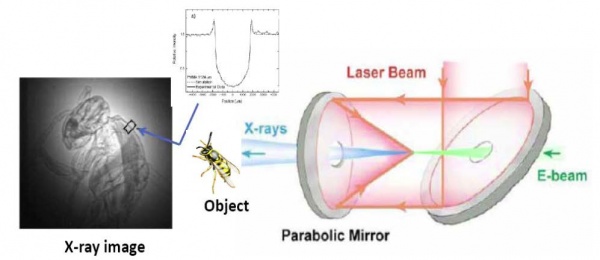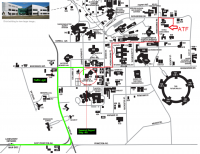Difference between revisions of "PHY542 spring 2016"
(→Course Overview) |
|||
| Line 25: | Line 25: | ||
[[Image:Example2.jpg|600px|Image: 600 pixels|center]] | [[Image:Example2.jpg|600px|Image: 600 pixels|center]] | ||
| − | + | ==Course Overview == | |
The course is intended for graduate students who want to gain knowledge about contemporary particle accelerators and their applications. During the semester, students will learn the basics on accelerator physics principles and accelerator operation as well have the unique opportunity to gain “hands-on” experience on an operational accelerator. Students will also learn advanced computational techniques in order to model and analyze their experiments. | The course is intended for graduate students who want to gain knowledge about contemporary particle accelerators and their applications. During the semester, students will learn the basics on accelerator physics principles and accelerator operation as well have the unique opportunity to gain “hands-on” experience on an operational accelerator. Students will also learn advanced computational techniques in order to model and analyze their experiments. | ||
Revision as of 18:57, 26 January 2016
| Class meet time and dates | Instructors |
|---|---|
|
|
Contents
Course Overview
The course is intended for graduate students who want to gain knowledge about contemporary particle accelerators and their applications. During the semester, students will learn the basics on accelerator physics principles and accelerator operation as well have the unique opportunity to gain “hands-on” experience on an operational accelerator. Students will also learn advanced computational techniques in order to model and analyze their experiments.
Learning Goals
The course will cover a wide array of the measurements and manipulations that are needed for beam dynamics studies. Upon completion, students are expected to understand the basic principles and relations of beam dynamics, many of which they will have experimentally verified. Furthermore, they will have gained experience in measurement techniques and analysis of experimental observations.
While emphasis will be given on experiments, it will also offer exposure to the latest accelerator computer simulation techniques.
Several major topics will be covered during the semester:
- source physics
- magnet measurements
- optical imaging and processing using both fast and integrating devices
- phase space mapping and emittance measurement
- longitudinal dynamics and energy spread, beam control
Overall, students will be exposed to a number of state-of-the-art diagnostics and experimental techniques.
Course Procedure
The course is structured into brief lectures which cover the theoretical background followed by lab sessions. For some experiments, students will be divided into small groups during the lab session that will perform experiments in parallel on different stations. The main experimental stations will be at the Accelerator Test Facility (ATF) at Brookhaven National Laboratory. Each group will be guided by one or more instructors and ATF staff persons who will assist the students and monitor their performance.
The last two weeks of the semester will be devoted to student presentations. You need to pick a topic and must decide by Mar. 23 in class. Your talk should be planned to take a total of 15 minutes. Five more minutes will be used for questions and comments.
LOCATION: The first class will be at Stony Brook University, Chemistry Building 124 All remaining classes will be at Brookhaven National Laboratory (BNL), Building 820
IMPORTANT: When you arrive at BNL's main gate, please inform the guard you are attending the Advanced Accelerator Laboratory Course at the ATF. You may be requested to check in at the nearby security trailer or research support building (Bldg. 400), where proper visitor identification may be required [1]. We highly recommend that you will arrive no later than 3:30 pm during your first time for registration.
Transportation info can be found here: [2] A list of BNL maps can be found here: [3]
Directions to the classroom are here:Textbook and suggested materials
- “The Theory and Design of Charged Particle Beams” by Martin Reiser, published by Wiley (1994)
- “Fundamentals of Beam Physics” by James Rosenzweig, published by Oxford 2003
- “Classical Electrodynamics”, third edition, by J.D. Jackson, published by Wiley (1999). Chapters 11 and 12 are of particular relevance to this course.
- Accelerator Physics, by S. Y. Lee
Grading
Students will be evaluated based on the following performances: class participation (85%) and final presentation on specific research paper (15%). There will be no final exam.
List of topics
The following topics are taken mostly from Physical Review Letters. All topics correspond to breakthrough experiments conducted at the Accelerator Test Facility.Two examples are here:
- 1. Dielectric Wakefield Acceleration of a Relativistic Electron Beam in a Slab-Symmetric Dielectric Lined Waveguide Download
- 2. Seeding of Self-Modulation Instability of a Long Electron Bunch in a Plasma Download
- 3. Experimental Observation of Suppression of Coherent-Synchrotron-Radiation–Induced Beam-Energy Spread with Shielding Plates Download
- 4. Generation of trains of electron microbunches with adjustable subpicosecond spacing Download
- 5. Subpicosecond Bunch Train Production for a Tunable mJ Level THz SourceDownload
- 6. High-quality electron beams from a helical inverse free-electron laser acceleratorDownload
- 7. Experimental Study of Current Filamentation Instability Download
- 8. Simple method for generating adjustable trains of picosecond electron bunches Download
- 9. Resonant excitation of coherent Cerenkov radiation in dielectric lined waveguides Download
NEW: Project topics for Spring 2015 class can be downloaded here: Projects
Safety Training
All students must complete online general training “Guest Site Orientation” (TQ-GSO).
In addition, here is the list of online ATF - specific training that you should also take prior to your arrival at ATF:
- Static Magnetic Fields
- LOTO Affected (Awareness)
- ATF Awareness
Note:
- Any student with medical conditions/implants affected by magnetic fields needs medical clearance prior to entry into exp hall or work with magnetic measurements.
Course Schedule
| Week | Date | Covered topic | Brief description of Experiment |
|---|---|---|---|
| 1 | Mon, Jan 26 | Class cancelled due snow | |
| 2 | Mon, Feb 02 | Class cancelled due snow | |
| 3 | Mon, Feb 09 | Course overview, administrative issues.Lecture | This class will take place at SBU Chem. 124. All remaining classes will be at BNL |
| 4 | Mon, Feb 16 | HOLIDAY (President's day) | |
| 5 | Mon, Feb 23 | Magnetic measurements [[media:Magmeasurements.pdf | Lecture] | ATF tour, Safety training (if any), Magnet field map of basic accelerator beam line components: dipole, quadrupole, chicane |
| 6 | Mon, Mar 02 | Review of beam sources, source physics, space-charge and simulation codes Intro Lecture Computational Lecture Computational HW1 | Electron gun operation, quantum efficiency measurement |
| 7 | Mon, Mar 09 | Magnet basics, concept of beam emittance Intro Lecture | Operation of quadrupole and solenoidal magnets; magnet misalignment effects; beam imaging; |
| 8 | Mon, Mar 16 | Spring Break (no class) | |
| 9 | Mon, Mar 23 | Transport of particle beams, Beam Acceleration HW1 Discussion Acceleration Lecture Computational HW2 | Operation of radio-frequency cavities, phase-dependence, alignment errors, dark currents |
| 10 | Mon, Mar 30 | Beam Diagnostics, emittance measurement techniques LectureComputational HW3 | Operation of position monitors; beam profile monitors; energy analyzer; emittance measurement with a magnet scan |
| 11 | Mon, Apr 06 | Advanced acceleration topics Lecture | Wakefield acceleration |
| 12 | Mon, Apr 13 | Masking Techniques HW3 Discussion | Beam masking techniques and bunch-train production |
| 13 | Mon, Apr 20 | Coherent Synchrotron Radiation (CSR)Lecture1 (DK)Lecture2 (DS) | Experimental demonstration of CSR; magnetic bunch compression |
| 14 | Mon, Apr 27 | Student Presentations | |
| 15 | Mon, May 04 | No Class |

